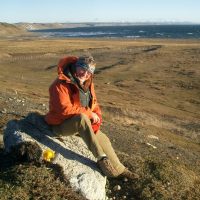More Antarctic Mysteries
August 29, 2011

Ian Dalziel continues to refine his reconstructions of Earth before Pangaea. But he’s also involved in many other research projects designed to answer a host of other questions, such as:
How fast is Antarctica losing ice? Scientists use data from the GRACE satellites to measure change in ice mass, but they first have to subtract out the gravitational effects of post glacial rebound, a slow rise in the bedrock resulting form 20,000 years of thinning and retreating ice. With the POLENET project (and its predecessor WAGN), Dalziel and colleagues at Ohio State University and elsewhere have been bolting metal plates to bits of exposed bedrock, called nunataks, across the frozen continent. GPS measurements at these sites over many years are providing the first direct measurements of vertical motion of the bedrock. Early results suggest Antarctica is not losing ice as fast as some recent estimates. This work will help scientists make more accurate projections of future sea level rise.
Are parts of Antarctica moving with respect to each other? If you add up the movement of all the tectonic plates around the world (measured with GPS), making a complete circuit of the globe, they just don’t zero out. Some people have proposed that an internal rift within Antarctica and movement of different pieces of the continent could help balance the ledger. Results from POLENET might help resolve the discrepancies.
When did the Scotia Sea open up? Scientists have proposed that the formation of Antarctica’s ice sheets was driven by a fast moving current of water encircling the continent and thermally insulating it, called the Antarctic Circumpolar Current. Both the current and the ice sheets formed around 30 million years ago. If the hypothesis is correct, geological barriers to the current would have to have been removed by that time. Dalziel and colleague Lawrence Lawver are investigating some magnetic anomalies in the Central Scotia Sea that complicate that tidy story.
